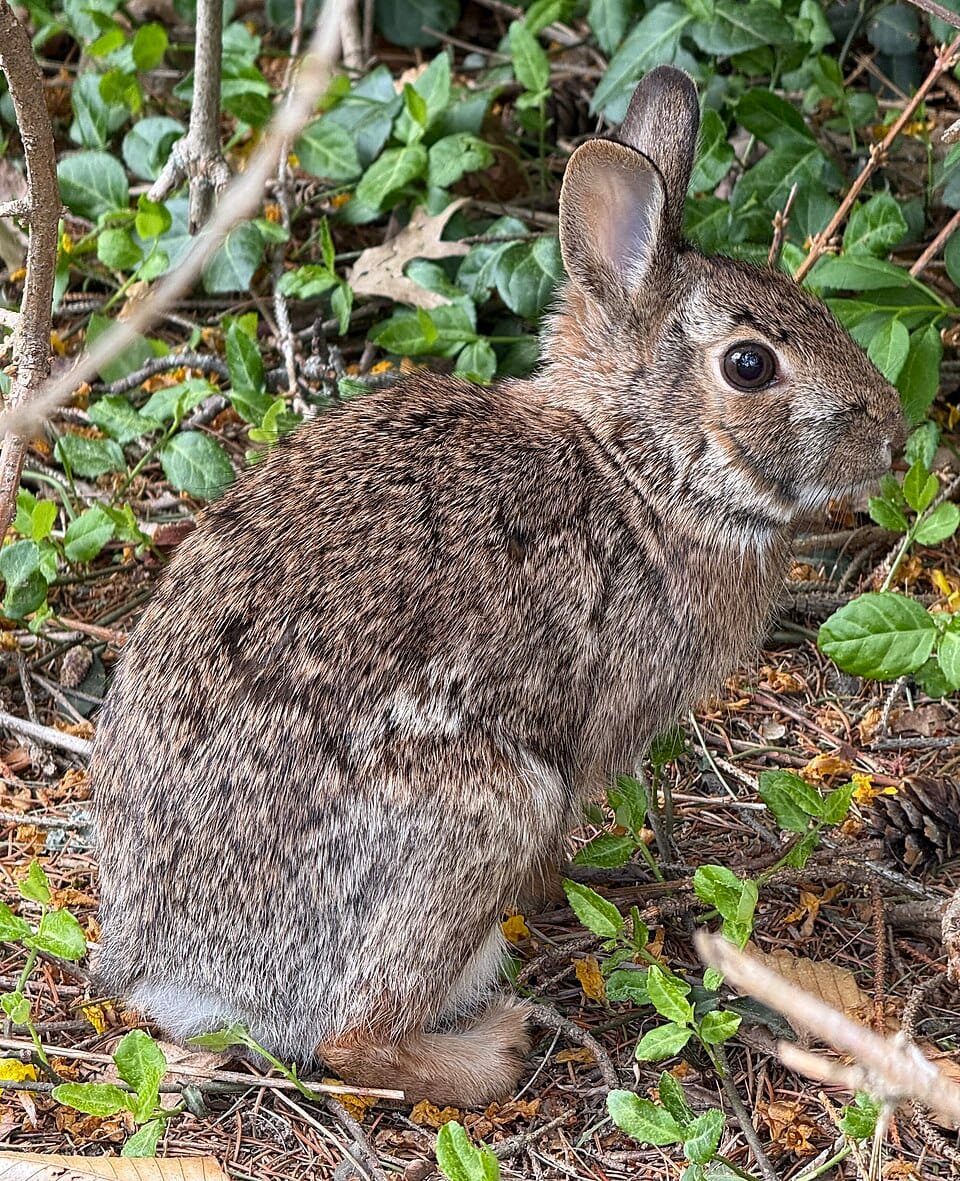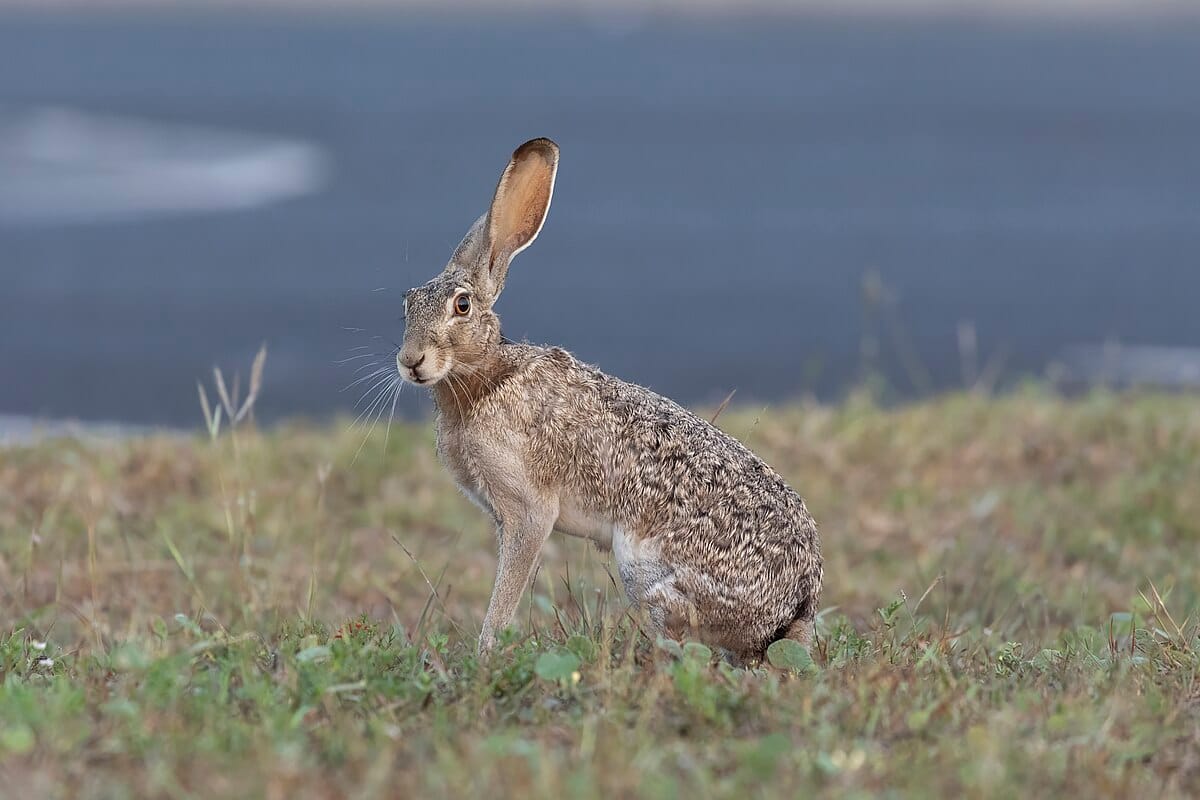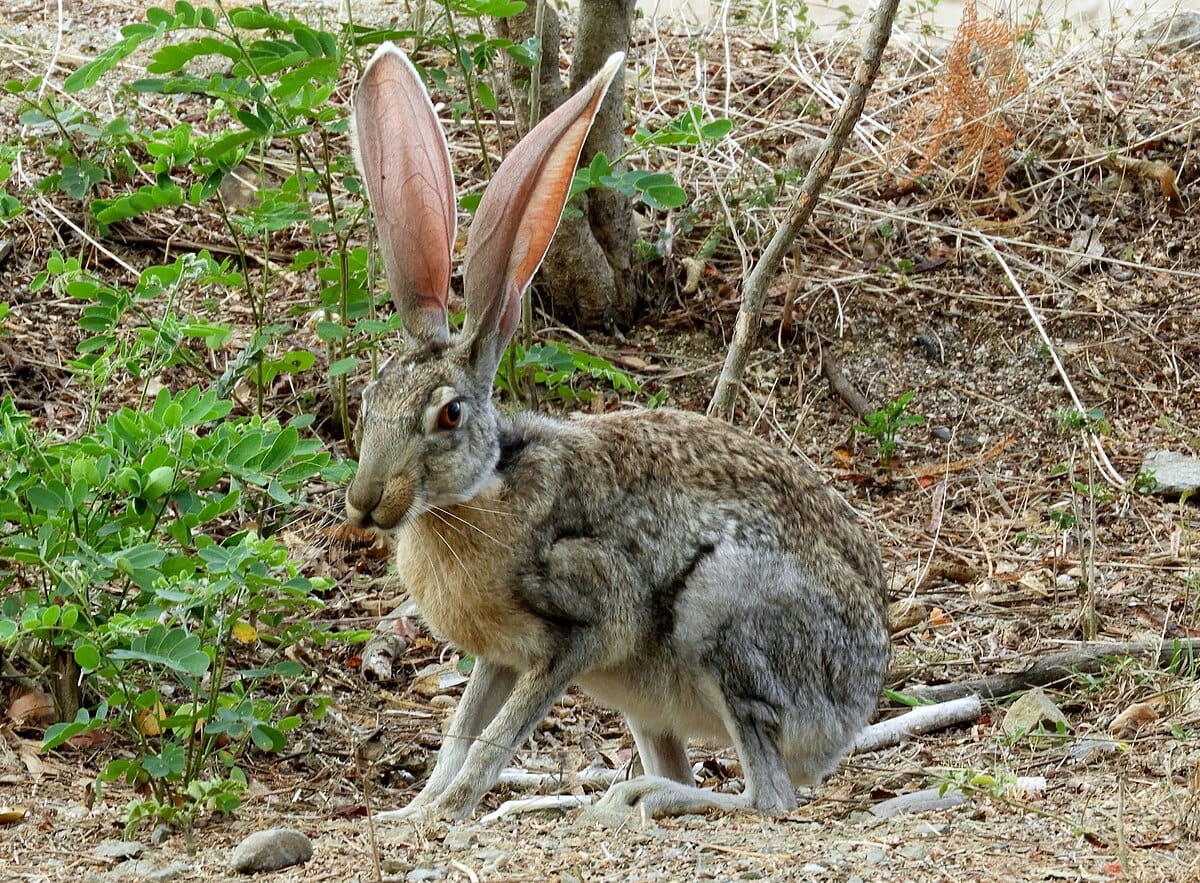Arizona’s deserts, grasslands, and mountains host a variety of fascinating wild rabbits. Knowing the types of wild rabbits in Arizona helps wildlife enthusiasts, hikers, and students identify and appreciate these creatures. From small, elusive cottontails to fast, long-legged jackrabbits, each species has its own habits, diets, and habitats. This guide explains their physical characteristics, behavior, diet, and reproduction. By learning about these wild rabbits, you’ll be better prepared to spot them in their natural environment and understand their role in Arizona’s ecosystems. The information here is beginner-friendly, accurate, and designed to give a clear picture of all 8 types of wild rabbits in Arizona.
1. Desert Cottontail

Physical Characteristics & Identification Tips
The Desert Cottontail (Sylvilagus audubonii) is a medium-sized rabbit weighing about 2.5–4 pounds. Its fur is brown-gray with a lighter belly and a signature white tail. The ears are moderately long, and its eyes are large and dark. This species has strong hind legs built for quick escapes but not long sprints. You can identify it by the slightly reddish fur on its rump and the combination of short, rounded ears with a bushy tail.
Behavior
Desert Cottontails are active during dawn and dusk. They rely on speed to escape predators, running in short zigzag patterns. Unlike some other rabbits, they rarely freeze in place. Desert Cottontails are generally solitary but will tolerate others nearby when food is abundant. They communicate using foot thumping and subtle scent marking.
Habitat and Range
This species prefers open areas with sparse vegetation, such as deserts, grasslands, and scrublands. In Arizona, they are widely distributed in the southern and central deserts and foothills. They often rest under bushes, rocks, or cacti to avoid predators and extreme temperatures.
Diet
Desert Cottontails feed on grasses, herbs, cacti, and shrubs. In the dry season, they supplement their diet with buds and twigs. They obtain most of their hydration from the plants they consume and rarely need standing water.
Reproduction and Life Cycle
Breeding occurs from early spring to late summer, with females producing multiple litters of 3–6 kits. Kits are born blind and hairless in shallow depressions called forms, often lined with grass. They become independent within 4–5 weeks. Lifespan in the wild is typically 1–3 years.
Fun Facts / Traits
- Can survive in extremely arid environments.
- Uses zigzag running patterns to evade predators.
- Highly adaptable to both desert and urban edges.
Human Interaction
They are common in rural areas and sometimes near urban gardens. They are not major pests but contribute to the food chain as prey for hawks, snakes, and coyotes.
2. Eastern Cottontail

Physical Characteristics & Identification Tips
The Eastern Cottontail (Sylvilagus floridanus) is slightly smaller than the Desert Cottontail. It has gray-brown fur with a white underside of the tail and moderately long ears. The eyes are large and alert. Eastern Cottontails are more compact, and their tails are fluffier. Unlike Desert Cottontails, they favor lower elevation habitats and are easier to spot in grassy or agricultural areas.
Behavior
Eastern Cottontails are primarily crepuscular. They are cautious and will freeze when sensing danger, then dart in short, unpredictable hops. They are mostly solitary but sometimes forage in loose groups. Foot thumping serves as an alarm to nearby rabbits.
Habitat and Range
They are found in southern and central Arizona, inhabiting grasslands, meadows, river valleys, and farmland edges. They tolerate low-density human activity and may be seen in gardens or parks.
Diet
Eastern Cottontails feed on grasses, herbs, buds, and leaves. In winter, they eat twigs, bark, and woody plant material. Their diet provides both nutrients and hydration.
Reproduction and Life Cycle
Breeding occurs from early spring to fall, with 2–5 litters per year. Each litter usually has 3–7 kits. Young are born blind and hairless in nests concealed in tall vegetation. They become independent within a few weeks, and adult rabbits live 1–3 years.
Fun Facts / Traits
- Named for its distinctive white tail resembling a cotton ball.
- Can adapt to environments near humans.
- Plays a crucial role as prey for local predators.
Human Interaction
Gardeners may occasionally see them nibbling plants. They are important prey species and help control plant growth in natural habitats.
3. Mountain Cottontail

Physical Characteristics & Identification Tips
The Mountain Cottontail (Sylvilagus nuttallii) is slightly larger than the Eastern Cottontail, weighing 2.5–4.5 pounds. Its fur is brown-gray with a pale belly, and its tail is white. Ears are slightly longer than Eastern Cottontails. Mountain Cottontails have strong hind legs for quick, short sprints, and their compact body allows them to hide among rocks and shrubs.
Behavior
Mountain Cottontails are crepuscular and stay close to cover. They are solitary and communicate mainly through foot thumping and scent marking. When threatened, they freeze briefly, then dash in a zigzag pattern to safety.
Habitat and Range
They prefer higher elevation habitats such as rocky slopes, mountain foothills, and meadows. Found in northern and central Arizona, they rely on shrub and rock cover to avoid predators.
Diet
They eat grasses, herbs, twigs, and buds. In winter, woody shrubs supplement their diet. Their selective grazing affects plant composition in their habitat.
Reproduction and Life Cycle
Breeding runs from early spring to late summer, producing multiple litters. Kits are born in shallow forms and grow quickly. Lifespan averages 2–3 years.
Fun Facts / Traits
- Excellent at blending into rocky terrain.
- Short zigzag movements help evade predators.
- Primarily a high-altitude species in Arizona.
Human Interaction
Occasionally observed by hikers in mountainous areas. They provide prey for foxes, hawks, and coyotes but rarely cause conflicts with humans.
4. Black-Tailed Jackrabbit

Physical Characteristics & Identification Tips
The Black-Tailed Jackrabbit (Lepus californicus) is large, weighing 3–6 pounds. It has long legs and ears, built for speed. Its fur is gray-brown with a black top of the tail. The lean body allows long-distance sprints to escape predators. Large, alert eyes and long ears help detect danger early.
Behavior
These rabbits are crepuscular and solitary. They rely on speed and endurance to evade predators, running in straight lines or zigzag patterns. They communicate using foot thumping and body movements.
Habitat and Range
Black-Tailed Jackrabbits inhabit open grasslands, deserts, and plains in southern and central Arizona. They avoid dense forests and human settlements.
Diet
Their diet includes grasses, herbs, buds, and twigs. They travel long distances to find food, especially in dry seasons.
Reproduction and Life Cycle
Breeding occurs from spring to summer. Litters usually have 2–6 leverets, which are born fully furred and mobile. Lifespan ranges 3–5 years.
Fun Facts / Traits
- Can run over 35 mph in short bursts.
- Black tail flashes help confuse predators.
- Prefers open terrain for predator visibility.
Human Interaction
Encounters mostly occur in grasslands or during hunting. They rarely enter urban areas but are important for predator-prey dynamics.
5. Antelope Jackrabbit

Physical Characteristics & Identification Tips
The Antelope Jackrabbit (Lepus alleni) is Arizona’s largest rabbit species. Adults can weigh up to 8 pounds with extra-long legs and ears. Its fur is gray-brown, and the tail is white underneath. This jackrabbit’s long legs allow exceptional speed and long leaps.
Behavior
Crepuscular and solitary, Antelope Jackrabbits rely on speed and camouflage. When startled, they can leap over 10 feet in a single bound. They are alert and cautious in open desert areas.
Habitat and Range
Found mainly in southern Arizona deserts and scrublands, especially in Sonoran Desert regions. They require open spaces with sparse cover to spot predators.
Diet
They eat grasses, shrubs, cacti, and desert plants. During dry months, they may eat twigs and dry plant matter to survive.
Reproduction and Life Cycle
Breeding occurs in spring and summer, with 1–3 litters per year. Litters have 2–5 leverets. Young are fully furred and mobile at birth and grow quickly.
Fun Facts / Traits
- Largest rabbit in Arizona.
- Can leap extraordinary distances to escape danger.
- Lives mostly in Sonoran Desert habitats.
Human Interaction
Mostly observed by wildlife enthusiasts and hunters. They rarely enter urban areas but are vital to desert ecosystems as herbivores and prey.
6. White-Tailed Jackrabbit

Physical Characteristics & Identification Tips
The White-Tailed Jackrabbit (Lepus townsendii) is large, with long legs and ears. It has a pale gray-brown coat and a white tail visible during flight. Its body is lean for long-distance running in open terrain.
Behavior
Crepuscular and solitary, these jackrabbits rely on speed and agility. They use straight sprints to escape predators, often signaling alarm by thumping their feet.
Habitat and Range
Found in open grasslands, plains, and desert valleys in northern and central Arizona. They prefer wide open spaces for visibility and escape.
Diet
They feed on grasses, herbs, and twigs. During winter, bark may supplement their diet. Long legs allow them to travel farther in search of food.
Reproduction and Life Cycle
Breeding occurs in spring and summer, producing 2–5 leverets per litter. Young are born fully furred and mobile. Lifespan is typically 3–4 years.
Fun Facts / Traits
- White tail flashes distract predators during flight.
- Lean body allows high-speed sprints over open terrain.
- Prefers plains and grasslands for safety.
Human Interaction
Rarely seen in urban areas. Important prey species for foxes, hawks, and coyotes.
7. White-Sided Jackrabbit

Physical Characteristics & Identification Tips
The White-Sided Jackrabbit (Lepus callotis) is medium to large, with long legs and a distinctive white stripe along the sides of its body. Fur is gray-brown and tail is small and white underneath. This species is less common in Arizona, mostly found in remote desert grasslands.
Behavior
Crepuscular and solitary. They are highly alert and rely on speed to evade predators. Foot thumping warns other rabbits of danger.
Habitat and Range
Found in northern and eastern Arizona, favoring arid grasslands and shrublands with open spaces for escape routes.
Diet
Feeds on grasses, leaves, and desert shrubs. Can survive long dry periods by eating tough vegetation.
Reproduction and Life Cycle
Breeding occurs from spring to summer. Litters have 2–4 leverets. Young are born fully furred and active. Lifespan averages 3–4 years.
Fun Facts / Traits
- Distinctive white side stripe is an easy identification feature.
- Adapted to remote desert grasslands.
- Leverages speed and agility to evade predators.
Human Interaction
Rarely encountered due to its remote habitat. Important for desert ecosystem balance and as prey for raptors and mammals.
8. Mexican Cottontail

Physical Characteristics & Identification Tips
The Mexican Cottontail (Sylvilagus cunicularius) is small to medium, with gray-brown fur, lighter belly, and a fluffy white tail. Its ears are moderately long, and its eyes are alert. It is rare in Arizona but has been reported historically in the southern deserts.
Behavior
Primarily nocturnal or crepuscular. Solitary, relies on dense shrub cover to hide from predators. Foot thumping signals danger to nearby rabbits.
Habitat and Range
Prefers desert scrublands and edges of grasslands. Rarely observed today, mostly historical sightings in southern Arizona deserts.
Diet
Feeds on grasses, shrubs, and leaves. Obtains moisture from plants, especially in arid environments.
Reproduction and Life Cycle
Breeding season is spring and summer. Litters of 3–5 kits. Kits are born blind and hairless, concealed in shallow forms. Lifespan is 1–3 years.
Fun Facts / Traits
- Rarely seen in modern Arizona wildlife surveys.
- Adapted to desert conditions.
- Historical range extends into northern Mexico.
Human Interaction
Encounters are extremely rare. Mostly known from historical records and museum specimens. Their conservation depends on habitat preservation.
Conclusion: Appreciating Wild Rabbits in Arizona
FAQs About Types of Wild Rabbits in Arizona
1. What are the most common types of wild rabbits in Arizona?
The most common types include Desert Cottontail, Eastern Cottontail, Mountain Cottontail, Black-Tailed Jackrabbit, and Antelope Jackrabbit. These species are widespread across deserts, grasslands, and mountainous areas.
2. How can I identify a Desert Cottontail?
Look for brown-gray fur, a white tail, moderately long ears, and reddish coloring on the rump. They weigh 2.5–4 pounds and have strong hind legs for short sprints.
3. Where do Eastern Cottontails live in Arizona?
They inhabit grasslands, meadows, river valleys, and farmland edges, mostly in central and southern Arizona. They prefer areas with tall grass for cover.
4. What is unique about Mountain Cottontails?
They live in higher elevations like rocky slopes and mountain foothills. Their compact body helps them hide among rocks and shrubs.
5. How fast can Black-Tailed Jackrabbits run?
They can sprint up to 35 mph in short bursts, using straight or zigzag paths to escape predators.
6. What do Antelope Jackrabbits eat?
Their diet consists of grasses, shrubs, cacti, and desert plants. They may also eat twigs and dry vegetation during droughts.
7. Are White-Tailed Jackrabbits common in Arizona?
They are found in northern and central Arizona, mostly in open grasslands and plains. They prefer wide open spaces for predator detection.
8. How to distinguish White-Sided Jackrabbits?
Look for the distinctive white stripe along the sides of their body. They inhabit remote desert grasslands and are less commonly seen.
9. Is the Mexican Cottontail still found in Arizona?
It is rare and mostly known from historical records. Its presence today is limited to isolated desert scrublands in southern Arizona.
10. What predators eat wild rabbits in Arizona?
Common predators include hawks, owls, foxes, coyotes, bobcats, and snakes. Each rabbit species has adapted escape strategies to avoid these predators.
11. How do rabbits communicate?
They thump their feet, leave scent markings, and use body movements to warn others of danger.
12. Are jackrabbits considered rabbits?
Yes, jackrabbits belong to the same family but are larger, with longer ears and legs, built for speed rather than burrowing.
13. How long do wild rabbits live in Arizona?
Most cottontails live 1–3 years, while larger jackrabbits may live 3–5 years in the wild, depending on predation and habitat conditions.
14. When do rabbits breed in Arizona?
Breeding occurs primarily from spring to summer. Some species like the Desert Cottontail and Antelope Jackrabbit may have multiple litters per year.
15. How many kits do rabbits have per litter?
Typically 2–7, depending on the species. Kits are born hairless or lightly furred, blind, and hidden in shallow nests or forms.
16. Can wild rabbits survive without water?
Most Arizona rabbits get sufficient hydration from plants. They rarely need standing water and can survive in arid environments.
17. Are Desert Cottontails nocturnal?
They are crepuscular, active mostly at dawn and dusk, but may forage at night in hot desert conditions.
18. Do jackrabbits burrow?
No, jackrabbits do not dig burrows. They rely on speed, camouflage, and open terrain to avoid predators.
19. How do rabbits avoid predators?
Cottontails use hiding spots and short zigzag sprints, while jackrabbits rely on long-distance running and sudden directional changes.
20. Can humans feed wild rabbits?
It’s not recommended. Wild rabbits have specialized diets, and human food can harm them or attract predators.
21. Are any wild rabbits in Arizona endangered?
Most are not endangered, but rare species like the White-Sided Jackrabbit may be vulnerable due to habitat loss.
22. Do rabbits damage gardens?
Some species like Eastern and Desert Cottontails may nibble garden plants, but they are usually not major pests.
23. How to tell jackrabbits from cottontails?
Jackrabbits are larger, with longer ears and legs. Cottontails are smaller and more compact with shorter ears.
24. Can rabbits survive Arizona winters?
Yes, they adapt by feeding on twigs, bark, and hardy shrubs when grasses are scarce.
25. Do rabbits hibernate?
No, Arizona rabbits stay active year-round, adjusting behavior and diet to seasonal changes.
26. What is the fastest rabbit species in Arizona?
The Black-Tailed and Antelope Jackrabbits are the fastest, capable of high-speed sprints to escape predators.
27. How do rabbits choose nesting sites?
Cottontails use shallow forms lined with grass, hidden under bushes or rocks. Jackrabbits’ young are born in concealed depressions in open areas.
28. How do rabbits affect Arizona ecosystems?
They control plant growth, provide prey for predators, and influence soil quality through grazing and burrow use.
29. Can rabbits coexist with livestock?
Yes, they generally coexist without major issues, feeding on leftover grasses and shrubs without competing heavily with livestock.
30. Are rabbits easy to observe in the wild?
Yes, if you know where to look. Early morning or evening is best. Stay quiet, use binoculars, and observe from a distance to avoid scaring them.
31. How do Arizona rabbits stay cool in hot deserts?
They rest in shaded areas during the hottest part of the day and remain active at cooler times like dawn and dusk.
32. Are rabbits nocturnal or diurnal?
Most species are crepuscular, meaning they are most active at dawn and dusk, though some may forage at night in deserts.
33. Do rabbits eat cacti?
Yes, especially in arid regions. They nibble cactus pads, buds, and flowers, obtaining both food and water from the plants.
34. How can I tell a Desert Cottontail from a Mountain Cottontail?
Desert Cottontails have reddish rump fur and slightly smaller bodies, while Mountain Cottontails are larger, more compact, and live in higher elevation rocky areas.
35. Are rabbits territorial?
Cottontails are mostly solitary and maintain small home ranges. Jackrabbits have larger ranges due to their mobility and food needs.
Read more: 5 Types of Wild Rabbits in Idaho (Pictures And Identification)
